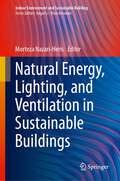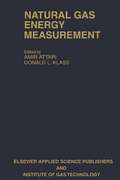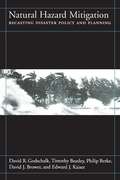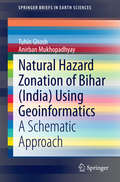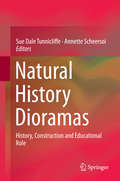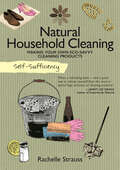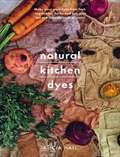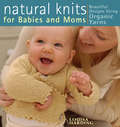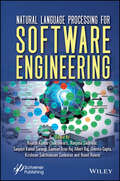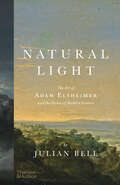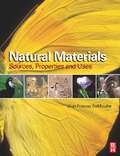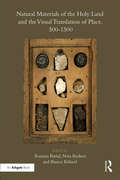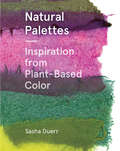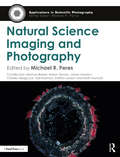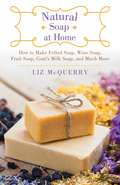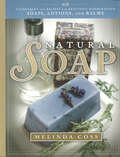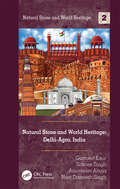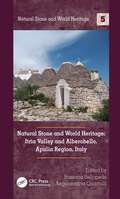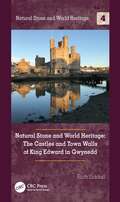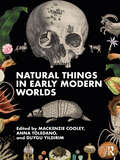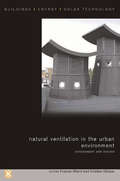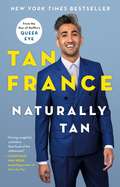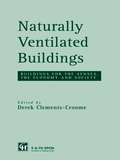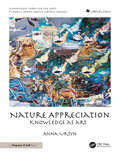- Table View
- List View
Natural Energy, Lighting, and Ventilation in Sustainable Buildings (Indoor Environment and Sustainable Building)
by Morteza Nazari-HerisThis book explores the theoretical background and provides an experimental analysis of using natural energy resources in sustainable building design. It brings together an international group of contributors focusing on ways natural energy, lighting, and ventilation can improve the performance of electrical, lighting, and mechanical systems. Contributions explore how natural resources can contribute to sustainable development goals while meeting energy demands and maintaining acceptable interior air quality and natural illumination needs. Coverage includes green building design, renewable energy integration, photovoltaic systems, small-scale wind turbines, natural lighting, and natural ventilation. Natural Energy, Lighting, and Ventilation in Sustainable Buildings offers practical and promising solutions for novel challenges in sustainable design for electrical engineers, energy engineers, architectural engineers, and related professionals, as well as researchers and developers from engineering science.
Natural Gas Energy Measurement
by Amir Attari Donald L. KlassPapers presented at the First and Second IGT Symposium, Chicago, IL, USA, 26-28 August 1985 and 30 April-2 May 1986.
Natural Hazard Mitigation: Recasting Disaster Policy And Planning
by David Brower Timothy Beatley Philip Berke Edward J. Kaiser David GodschalkThe first half of the 1990s saw the largest and most costly floods, hurricanes, and earthquakes in the history of the United States. While natural hazards cannot be prevented, their human impacts can be greatly reduced through advance action that mitigates risks and reduces vulnerability.Natural Hazard Mitigation describes and analyzes the way that hazard mitigation has been carried out in the U.S. under our national disaster law, the Robert T. Stafford Disaster Relief and Emergency Assistance Act. It is the first systematic study of the complete intergovernmental system for natural hazard mitigation, including its major elements and the linkages among them.The book: analyzes the effectiveness of the Stafford Act and investigates what is contained in state hazard mitigation plans required by the Act studies how federal hazard mitigation funds have been spent explores what goes into decision making following a major disaster looks at how government mitigation officials rate the effectiveness of the mitigation system suggests changes that could help solve the widely recognized problems with current methods of coping with disasters.Damages from natural disasters are reaching catastrophic proportions, making natural hazard mitigation an important national policy issue. The findings and recommendations presented in this volume should help to strengthen natural hazard mitigation policy and practice, thereby serving to reduce drains on the federal treasury that pay for preventable recovery and relief costs, and to spare residents in areas hit by natural disasters undue suffering and expense. It is an informative and eye-opening study for planners, policymakers, students of planning and geography, and professionals working for government agencies that deal with natural hazards.
Natural Hazard Zonation of Bihar (India) Using Geoinformatics
by Tuhin Ghosh Anirban MukhopadhyayWith increased climate variability, aggravated natural hazards in the form of extreme events are affecting the lives and livelihoods of many people. This work serves as a basis for formulating a 'preparedness plan' to ensure the effective policy formulation for planned development. Increased demand and competition with a high degree of variability have forced people to struggle in order to prosper. Good governance and innovative policy formulation are necessary to create a resilient society. This may promote a paradigm shift in the mindset on and perceptions of natural hazards and their impacts on development and growth. This new perspective will make people more concerned about minimizing the loss of life, property, and environmental damage and directly safeguard the development process. This book presents a detailed methodological approach to monitoring meteorological, hydrological, and climate change aspects to help resolve issues related to our environment, resources, and economies in the changing climate situation.
Natural History Dioramas
by Sue Dale Tunnicliffe Annette ScheersoiThis book brings together in a unique perspective aspects of natural history dioramas, their history, construction and rationale, interpretation and educational importance, from a number of different countries, from the west coast of the USA, across Europe to China. It describes the journey of dioramas from their inception through development to visions of their future. A complementary journey is that of visitors and their individual sense making and construction of their understanding from their own starting points, often interacting with others (e. g. teachers, peers, parents) as well as media (e. g. labels). Dioramas have been, hitherto, a rather neglected area of museum exhibits but a renaissance is beginning for them and their educational importance in contributing to people's understanding of the natural world. This volume showcases how dioramas can reach a wide audience and increase access to biological knowledge.
Natural Household Cleaning: Making Your Own Eco-Savvy Cleaning Products (Self-Sufficiency)
by Rachelle StraussDiscover a safer, greener, less expensive way to keep your house clean with this simple guide to making your own natural products. This friendly book will help you become more self-sufficient while benefiting your health, the environment, and your bank balance. Natural Household Cleaning is packed with easy-to-follow recipes for natural alternatives to common commercial cleaning products—all using harm-free ingredients found in your kitchen cupboard! Lemons, salt, vinegar, baking soda, and club soda are just some of the natural ingredients that can be used to clean the kitchen, bathroom, bedroom, floors, and everything in between. Many of us don&’t realize just how easy it is to make your own cleaning products and achieve truly amazing results. Turn a chore into a pleasure and discover a whole new way to clean!
Natural Kitchen Dyes: Make Your Own Dyes from Fruit, Vegetables, Herbs and Tea, Plus 12 Eco-Friendly Craft Projects (Crafts Ser.)
by Alicia Hall&“Hall digs into kitchen chemistry in this cozy guide to using plants to make dyes . . . This fun collection will be a valuable addition to any DIY library.&” —Publishers Weekly With Natural Kitchen Dyes you can explore the magical world of natural dyes, without the need of a garden full of dye plants. Our kitchens are a great source of natural dye colors, from vegetable peels that create blush pinks and peaches, fruit skins that make lemon yellows, a green dye sourced from carrot tops, dried spices, and used tea bags to create vibrant yellows, rich terracottas, and deep browns. Natural Kitchen Dyes takes you through the exciting process of creating these wonderful natural colors, dyeing fabric with the dyes, and suggests ingenious ways to get your hands on some natural dye sources. Accompanying the natural dye recipes in the book are ten environmentally conscious projects, which have been created not only to show off the natural dyes beautifully, but to help eliminate waste. Several of the projects actually utilise waste that would otherwise be composted or recycled such as old clothes turned into bags and patchwork floor cushions, to dried pulses past their expiration date used to make a beaded necklace. &“This is my sort of book: no need to start your adventure with a shopping expedition for ingredients—at least not to begin with—it&’s all there in the kitchen for a safe, spur-of-the-moment indulgence.&” —The Journal for Weavers, Spinners & Dyers &“Hall outlines a kid-friendly craft that just might engage adults too.&” —Booklist
Natural Knits for Babies and Moms: Beautiful Designs Using Organic Yarns
by Louisa HardingThis inspired collection of patterns for mother and baby includes designs with a simple flare and an elegant, modern feel for use with organically grown, undyed yarns. The projects are designed for beginning to average knitters so that essential baby accessories such as booties, mittens, hats, and simple knitted toys are quickly completed and instantly cherished. A cot blanket is an example of a group project designed to be made in one evening, and slightly more ambitious designs include an adorable dress, a chunky jacket, or a kimono sweater for a baby and wonderful, cozy items for mothers such as an unusual "bump" sweater for pregnant women, nursing sweaters that are convenient and stylish, and herb-scented pillows that delight the eye and soothe the spirit.
Natural Language Processing for Software Engineering
by Romil Rawat Rajesh Kumar Chakrawarti Sanjaya Kumar Sarangi Shweta Gupta Krishnan Sakthidasan Sankaran Ranjana Sikarwar Samson Arun Raj Albert RajDiscover how Natural Language Processing for Software Engineering can transform your understanding of agile development, equipping you with essential tools and insights to enhance software quality and responsiveness in today’s rapidly changing technological landscape. Agile development enhances business responsiveness through continuous software delivery, emphasizing iterative methodologies that produce incremental, usable software. Working software is the main measure of progress, and ongoing customer collaboration is essential. Approaches like Scrum, eXtreme Programming (XP), and Crystal share these principles but differ in focus: Scrum reduces documentation, XP improves software quality and adaptability to changing requirements, and Crystal emphasizes people and interactions while retaining key artifacts. Modifying software systems designed with Object-Oriented Analysis and Design can be costly and time-consuming in rapidly changing environments requiring frequent updates. This book explores how natural language processing can enhance agile methodologies, particularly in requirements engineering. It introduces tools that help developers create, organize, and update documentation throughout the agile project process.
Natural Light: The Art Of Adam Elsheimer And The Dawn Of Modern Science
by Julian BellA brand-new perspective on early modern art and its relationship with nature as reflected in this moving account of overlooked artistic genius Adam Elsheimer, by an outstanding writer and critic. Seventeenth-century Europe swirled with conjectures and debates over what was real and what constituted “nature,” currents that would soon gather force to form modern science. Natural Light deliberates on the era’s uncertainties, as distilled in the work of long underappreciated artist Adam Elsheimer (1578–1610), a native of Frankfurt who settled in Rome and whose diminutive and mysterious narrative compositions related figures to landscape in new ways, projecting unfamiliar visions of space at a time when Caravaggio was polarizing audiences with his radical altarpieces and early modern scientists were starting to turn to the new “world system” of Galileo. His visual inventions influenced many famous artists—including Rembrandt van Rijn, Claude Lorrain, and Nicolas Poussin. Julian Bell guides the reader through key Elsheimer artworks, examining the contexts behind them before exploring the new imaginative thoughts that opened up in their wake. He also explores the experiences of Elsheimer and other Northern artists in the literary, artistic, and scientific culture of 1600s Rome. Although his life was tragically short, Elsheimer’s legacy endured and prints of his work were widely spread throughout Europe, with his influence extending as far as the Indian subcontinent.
Natural Materials
by Jean DeMoutheMost museums collections contain a wide variety of natural materials, and a diverse range of knowledge is necessary to keep so many types of objects at their best. This book studies the composition, structure and properties of natural materials such as wood, paper, amber, coral and feathers, and discusses the potential hazards they face, as well as the appropriate conservation techniques to use for each. Providing plenty of detail in an easily accessible format, Natural Materials is a useful resource for students, professionals and collectors alike.
Natural Materials of the Holy Land and the Visual Translation of Place, 500-1500
by Renana Bartal Neta Bodner Bianca KuhnelNatural Materials of the Holy Land and the Visual Translation of Place, 500-1500, focuses on the unique ways that natural materials carry the spirit of place. Since early Christianity, wood, earth, water and stone were taken from loca sancta to signify them elsewhere. Academic discourse has indiscriminately grouped material tokens from holy places and their containers with architectural and topographical emulations, two-dimensional images and bodily relics. However, unlike textual or visual representations, natural materials do not describe or interpret the Holy Land; they are part of it. Tangible and timeless, they realize the meaning of their place of origin in new locations. What makes earth, stones or bottled water transported from holy sites sacred? How do they become pars pro toto, signifying the whole from which they were taken? This book will examine natural media used for translating loca sancta, the processes of their sanctification and how, although inherently abstract, they become charged with meaning. It will address their metamorphosis, natural or induced; how they change the environment to which they are transported; their capacity to translate a static and distant site elsewhere; the effect of their relocation on users/viewers; and how their containers and staging are used to communicate their substance.
Natural Palettes: Inspirational Plant-Based Color Systems
by Sasha Duerr“The plant-lover’s alternative to the Pantone color guide.”—Julia Sherman, creator of Salad for President Renowned natural dyer, artist, and educator Sasha Duerr envisions a new age of fresh, modern color palettes, drawing from our original source of inspiration and ingredients—the natural world around us. This innovative plant-based color guide includes twenty-five palettes with five hundred natural color swatches, providing a bounty of ideas for sustainable fashion, textiles, fine art, floral design, food, medicine, gardening, interior design, and other creative disciplines. Bring the healing power of forest bathing into your home with a palette of spruce cones, pine needles, and balsam branches. Move past Pantone and embrace the natural balance of a pollinator palette with Hopi sunflower, red poppy, echinacea, and scabiosa.Duerr complements her palettes with illuminating reflections on connections between color and landscape, the healing properties of medicinal plants, the ways food and floral waste can be regenerated to enhance lifestyle experiences, the ecological benefits of using natural colors, and more. You may never view color—or the plants that surround us—the same way again.
Natural Science Imaging and Photography (Applications in Scientific Photography)
by Michael R. PeresThis book provides an in-depth exploration of scientific photography. Highlighting the best practices needed to make, distribute, and preserve scientific visual information using digital photographic methods and technologies, it offers solutions to some of the biggest challenges facing photographers. Written by a team of international, award-winning image makers with over 300 years of cumulative experience, this comprehensive resource explains the foundations used, the tools required, and the steps to needed for creating the optimal photograph in a range of environments and circumstances. Topics covered include: • ethical practices • aerial photography • close-up and macro photography • computational photography • field photography • geological photography • imaging with invisible spectrums • photographing small animals in captivity • time-based imaging • image processing in science Showcasing modern methods, this book equips readers with the skills needed to capture and process the best image possible. Designed for basic and intermediate photographers, Natural Science Imaging and Photography exists as an essential contemporary handbook.
Natural Soap at Home: How to Make Felted Soap, Wine Soap, Fruit Soap, Goat's Milk Soap, and Much More
by Liz McQuerryThe creator of the natural skin care line Moon Magic, Liz McQuerry offers here a step-by-step guide for natural cold-process soap crafting. Mostly utilizing kitchen ingredients to create a variety of innovative soap blends—including felted soap, beer soap, and seasonal soaps—McQuerry will put you in touch with your inner alchemist. From body bars to hair care bars, with wonderful tidbits and advice on herbs and essential oil blends, you and your family will enjoy a clean like never before. Here are instructions for:Mermaid Kisses Salty Sea SoapGolden Coconut Milk SoapWine and Rose SoapFelted Soap StonesRefreshing Lemon Solid Shampoo BarsBeard Wash Solid Soap BarsAnd more!After you learn to make your own soap, you’ll also discover how to scent, color, design, troubleshoot, and even sell your soap. McQuerry’s soaps make for attractive and personal bathroom and kitchen décor at home, as well as nifty gifts for just about any occasion.
Natural Soap: Techniques and Recipes for Beautiful Handcrafted Soaps, Lotions and Balms
by Melinda CossLearn how to make natural soaps that are beautiful, luxurious, and kind to your skin with this comprehensive guide by the master soap maker.In Natural Soap, Melinda Coss focuses on natural ingredients and provides a wonderful range of recipes for bar and liquid soaps as well as creams, lotions, and balms. With clear, accessible instructions, she covers all the techniques and equipment you will need to get started making these wonderful soaps. The recipes include fruits soaps. scrub bars, skin creams, flower waters, and much more. There’s even a section on special effects for a real treat. Melinda also includes essential advice on starting your own soap making business for anyone looking to profit from their newfound skills.
Natural Stone and World Heritage: Delhi-Agra, India (Natural Stone and World Heritage)
by Gurmeet Kaur Sakoon N. Singh Anuvinder Ahuja Noor Dasmesh SinghThis book discusses heritage stones which were used in the making of the architectonic heritage of Delhi and Agra, encompassing UNESCO world heritage sites and heritage sites designated as prominent by the Indian government. The most famous monument of the two cities is the ‘Taj Mahal’ of Agra. The book focuses on the geological characteristics of the famous Makrana marble, red sandstone and other sandstone variants of the Vindhyan basin and Delhi quartzite, the most widely used stones in almost all the monuments, as well as on their quarries. The work also aims to sensitise the public to protecting and preserving the architectonic heritage of these two densely populated cities in India as repositories of our past cultures and traditions. Identifying the nature and provenance of stones/rocks used in construction will lead to better restoration for future generations, in light of the deterioration of architectonic heritage through various natural weathering agencies and anthropogenic activities. The book will serve as a useful source book to economic geologists, geologists, archaeologists, architects, historians and stone industry operators specifically and to academic and non-academic communities, travellers and tourism industry operators in general. The book will benefit students, researchers, and rock enthusiasts spanning all age groups and academic levels.
Natural Stone and World Heritage: Itria Valley and Alberobello, Apulia Region, Italy (ISSN)
by Rossana Bellopede Angelamaria QuartulliApulian limestones constitute the historic building constructions of the Puglia region (in the south of Italy) named trulli (representing an outstanding universal value for UNESCO), but also other stone buildings of the well-known Itria Valley. Trulli are drywall (mortarless) constructions made of roughly worked limestone blocks collected from neighbouring fields. The limestone for trulli is quarried from different Apulian localities and, together with another local lithotype, represents the stone heritage of the Itria Valley.This book begins with an introduction to the region of southern Italy where trulli and other typical stone architecture can be found. The Itria Valley with its towns and landscape and the town of Alberobello are described from an architectural point of view. The second section describes the different examples of building constructions in local stone of the Itria Valley, focusing on ancient and contemporary quarries. In this part petrographic and physical mechanical characteristics of the main kind of limestones are reported and discussed. The third part focuses on the main examples of stone architecture of Itria Valley, distinguishing the historical rural buildings from the other historical civil ones. In this section particular attention is given to best practices of evaluation action, protection rules and restoration methods for stone heritage in Itria Valley and Alberobello.This book serves as a useful source of information to geologists, archaeologists, architects, historians and stone industry operators specifically, and to academic and non-academic communities, travellers, and tourism industry operators in general. The book will also be of interest to students, researchers, and rock enthusiasts spanning all age groups and academic levels.
Natural Stone and World Heritage: The Castles and Town Walls of King Edward in Gwynedd (Natural Stone and World Heritage)
by Ruth SiddallThis book is about the stone used to build the castles of Edward I in North West Wales. It provides a description of the available geological resources and the building materials used in the construction of Caernarfon, Conwy, Harlech and Beaumaris Castles. It takes a broad view of this subject, placing the stone used in the castles in the context of both earlier and later buildings across the region of study, from the Neolithic up until the present day. The book will serve as a useful source book for geologists, archaeologists, architects, representatives of the natural stone industry, historians and cultural heritage management professionals specifically and for academic and non-academic communities, travellers and tourism industry operators in general.
Natural Things in Early Modern Worlds
by Mackenzie Cooley Anna Toledano Duygu YıldırımThe essays and original visualizations collected in Natural Things in Early Modern Worlds explore the relationships among natural things—ranging from pollen in a gust of wind to a carnivorous pitcher plant to a shell-like skinned armadillo—and the humans enthralled with them. Episodes from 1500 to the early 1900s reveal connected histories across early modern worlds as natural things traveled across the Indian Ocean, the Ottoman Empire, Pacific islands, Southeast Asia, the Spanish Empire, and Western Europe. In distant worlds that were constantly changing with expanding networks of trade, colonial aspirations, and the rise of empiricism, natural things obtained new meanings and became alienated from their origins. Tracing the processes of their displacement, each chapter starts with a piece of original artwork that relies on digital collage to pull image sources out of place and to represent meanings that natural things lost and remade. Accessible and elegant, Natural Things is the first study of its kind to combine original visualizations with the history of science. Museum-goers, scholars, scientists, and students will find new histories of nature and collecting within. Its playful visuality will capture the imagination of non-academic and academic readers alike while reminding us of the alienating capacity of the modern life sciences.
Natural Ventilation in the Urban Environment: Assessment and Design (BEST (Buildings Energy and Solar Technology))
by Francis Allard Cristian GhiausThroughout the world, there is an increasing interest in ecological design of buildings, and natural ventilation has proved to be the most efficient low-energy cooling technique. Its practical application, however, is hindered by the lack of information on the complex relationship between the building and its urban environment. In this book, a team of experts provide first-hand information and tools on the efficient use of natural ventilation in urban buildings. Key design principles are explained, enabling readers to decide on the best solution for natural ventilation of buildings, taking into account climate and urban context. In the initial sketches, architects need answers to open problems such as 'what kind of solution to adopt' and 'how to modify existing strategies to exploit the potential of the site'. This book formalizes the multi-criteria analysis of candidate solutions based on quantitative and qualitative estimation of the driving forces (wind and buoyancy), as well as of the barriers induced by the urban environment (wind speed reduction, noise and pollution) and gives a methodology for optimal design of openings. The book is accompanied by a FREE CD, containing software for assessing the potential of a given site, estimating wind speed and dimensioning the openings for natural ventilation. The methodologies and tools are tested, self-contained and user friendly. About the editors The editors, Cristian Ghiaus and Francis Allard, are affiliated with the University of La Rochelle, France. The authors and reviewers combine expertise from universities, research institutions and industry in Belgium, France, Great Britain, Greece, Portugal and Switzerland.
Naturalism’s Imaginary Museum, French Art, and the Eclectic Nineteenth Century (University of Toronto Romance Series)
by Sara PappasNaturalism’s Imaginary Museum, French Art, and the Eclectic Nineteenth Century examines one of the most revered art historical narratives of Western art: the famous turning point for painting and sculpture usually emblematized by the works of Édouard Manet and then the Impressionists. Instead of the usual revaluation of this turning point, Sara Pappas argues for the importance of the failure to find a cohesive story for the art world in the period itself, a difficulty that carries forward to galleries today. In order to demonstrate the importance of incongruity and disorder, Pappas brings together two worlds that may seem incompatible: nineteenth-century literary writers involved in naturalism and the organization of permanent collections of later nineteenth-century French art in today’s museums. Drawing on the art novels and art criticism of these writers, the book provides optimal access to the questions that continue to haunt the categorization and display of nineteenth-century art.
Naturally Tan: A Memoir
by Tan FranceA USA Today Hottest Book of the Summer for 2019!A Best Nonfiction Book for 2019 in Women's Day!One of Hello Giggles's "Most Anticipated Books of 2019 to Add to Your Reading List"!“Just when I thought I knew everything about Tan, he hits me with this. His story is so heartwarming, and wickedly funny.” —Antoni PorowskiIn this heartfelt, funny, and touching memoir, one of the stars of Netflix’s Emmy Award-winning smash-hit Queer Eye reveals how an Englishman raised in a traditionally religious home became a fashion icon—and the first openly gay, South Asian man on television—simply by being Naturally Tan.In this heartfelt, funny, touching memoir, Tan France tells his origin story for the first time. With his trademark wit, humor, and radical compassion, Tan reveals what it was like to grow up gay in a traditional South Asian family, as one of the few people of color in South Yorkshire, England. He illuminates his winding journey of coming of age, finding his voice (and style!), and marrying the love of his life—a Mormon cowboy from Salt Lake City. From one of the stars of Netflix’s runaway hit show Queer Eye, Naturally Tan is so much more than fashion dos and don’ts—though of course Tan can’t resist steering everyone away from bootcut jeans! Full of candid observations about U.S. and U.K. cultural differences, what he sees when you slide into his DMs, celebrity encounters, and the behind-the-scenes realities of “reality TV,” Naturally Tan gives us Tan’s unique perspective on the happiness to be found in being yourself.In Tan's own words, “The book is meant to spread joy, personal acceptance, and most of all understanding. Each of us is living our own private journey, and the more we know about each other, the healthier and happier the world will be.”
Naturally Ventilated Buildings: Building for the senses, the economy and society
by Derek Clements-CroomeWhile there are many historical examples of successful naturally ventilated buildings, standards for indoor climate have tended to emphasise active, mechanical airflow systems rather than passive natural systems. Despite its importance, knowledge about the performance of naturally ventilated buildings has remained comparatively sparse. With ten key research papers this book seeks to address this lack of information.
Nature Appreciation: Knowledge as Art
by Anna UrsynIf asked what all people can agree with, we can see one answer: we all love Nature, one way or another. In this book, impossible creatures (one can perceive as atoms, molecules, or minerals) playfully deliver computer codes, with an underlying notion that everything is connected: in nature, materials, sciences, techniques, computing, and the arts. In this innovative space, these characters introduce programming. While coding is intertwined into simple facts, Nature Appreciation shows ways we appreciate nature, thus, helping us learn in a playful, nonjudgmental way.Knowledge is divided into subjects and classes at schools, colleges, then universities. Facts, processes, and rules cannot be separated. They are all connected: biochemistry, product materiality changes from matter to energy and vice versa, and conversion of one state into another. In this book, they are considered as different ways of living, such as: Geo, earth, soil, minerals, and natural resources experienced when walking on the ground. Water, transportation, ecosystems, leisure time, and energy related to water environs. Air, energy, space and planets travel, galatic objects, space junk. One can fly or carry materials and devices through it. Waves, communication, transformation, music, light, color - everything related to light, electromagnetic waves, oscillation, and vibration. Also Visually Static World, Space Exploration, and Deep Underwater are also included. It is a part of the “Knowledge Through the Arts” series, consisting of:Dance Code - Dance Steps as a CodeNew Storytelling - Learning Through MetaphorsCode Appreciation - Reshaping KnowledgeNature Appreciation - Knowledge as Art
